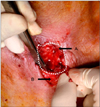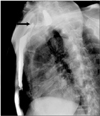Abstract
We experienced a case of wide necrosis of the cervical gastric conduit during esophageal cancer surgery. We attempted to repair this defect with various methods including conservative care, stents two times, and sternocleidomastoid muscle flap without successful results. Finally, we were able to reconstruct the gastric conduit defect with rotational pectoralis major musculocutaneous (PMM) flap. PMM flap is thought to be a reconstruction method applicable to the intractable gastric conduit defect.
In spite of recent advances in esophageal cancer surgery, the management of an anastomosis leak or conduit necrosis is very challenging. Several methods for managing anastomotic leakage or necrosis have been suggested, including conservative treatment and more aggressive treatments, such as stent insertion and vascularized pedicle tissue flaps. We report a case of reconstruction using a rotational pectoral musculocutaneous flap for the intractable gastric conduit necrosis.
A 63-year-old man was diagnosed with esophageal cancers, located at 18 cm and 30 cm from the incisor (clinical stage T2 and T4N1M0 respectively). He had received chemotherapy with 5-fluorouracil and cisplatin 5-cycle for 6 months. Partial responses were achieved and he was recommended with radiation therapy, but he refused. So he was transferred to Seoul St. Mary's Hospital for operation (Fig. 1). Preoperative study showed the stage of T1 and T3N1M0 respectively.
Right thoracotomy and esophagectomy, with mediastinal node dissection, were performed initially. There was no regional cancer invasion or remarkable lymphadenopathy. Then gastric tube was made for conduit with GIA staplers via a median laparotomy. After a cervical node dissection, the gastric conduit was ascended via subcutaneous route to the left neck. In addition, end to side esophagogastrostomy was made manually. The final pathology report showed the stages were T1 and T2N1M0. Immediate postoperative course was uneventful, and esophagogram on postoperative day (POD) 9 showed no leakage and passage disturbance. But cervical wound was swollen with redness after 3 days of feeding, and pus-like discharge with food material came out when the wound was incised. The leak did not improve for 10 days of conservative care. Endoscopy showed about 1 × 1 cm sized defect at the stump of gastric conduit, just below the anastomosis. The covered stent was inserted, but to no avail. Therefore, we mobilized the clavicular head of the right sternocleidomastoid (SCM) muscle with clavicular periosteum about 3 × 2 cm in size. After debridement of the defect margin, we repaired the defect with the periosteal surface of SCM flap on POD33. We recommended 'Not for Os,' but he fed earlier on POD5, and a leak was noted again on POD8. We retried to repair the defect with right pectoral major musculocutaneous (PMM) flap, about 4 × 3 cm sized on POD45. The margins of defect became thicker with granulation tissue and previous muscle flap (Fig. 2). As such, it was easy to repair. The procedure was like below description. A zigzag incision was made on the right anterolateral chest wall. After dissection of pectoralis major muscle preserving the thoracoacromial vessel using Doppler ultrasonography, the PMM flap was made about 4 cm wide. The muscle was denervated with electrocautry. And then we made a subcutaneous tunnel up to the level of clavicle to connect the chest and defect site with caution to PMM flap vascular compression. The flap was mobilized to the defect, and the defect was covered with the PMM flap in the manner of rotation, in other words, the skin side of the flap was directed toward lumen of gastric conduit. Repair of the flap and gastric conduit was performed with interrupted suture in 2-layer fashion with 4-0 vicryl suture (Ethicon Inc., Somerville, NJ, USA). We used split thickness skin graft from right thigh to repair of the donor and recipient skin defect. Closed drains were inserted to right chest and neck wound (Fig. 3). Oral diet could be possible on POD9 after PMM repair and the patient was discharged on POD12 (Fig. 4).
In spite of recent advances in esophageal cancer surgery, the management of an anastomosis leak or conduit necrosis is very challenging [1,2]. Several methods for managing anastomotic leakage or necrosis have been suggested, including conservative treatment and more aggressive treatments, such as stent insertion and vascularized pedicle tissue flaps [1,3]. But the most effective treatment method for esophagogastric anastomotic leaks or fistula still remains controversial [2].
Initially we tried conservatively, and inserted the self-expanding metallic coated stents. The stent did not work because of the size discrepancy and migration even being fixated with suture. The primary repair was not suitable because of a large defect and friable wound edge. So we repaired this defect with SCM muscle flap and periosteum. The utility of the SCM muscle flap for primary or reinforced repair of an esophageal perforation is well known [4]. But because of poor reliability of blood supply and high rate of the flap necrosis, the SCM muscle flap has not been used, as commonly as the pectoralis major muscle flap, to repair the cervical esophageal anastomotic leakage after esophageal reconstruction [1,5]. Because the defect was due to not anastomosis leak, but gastric conduit necrosis, at first the size of the defect was 1 × 1 cm, but finally, the size increases up to 4 × 5 cm. In our case, the volume of SCM muscle flap and periosteum was too small to cover for the defect and failed. The advantages of PMM flap for head and neck reconstruction are well known because it is highly mobile and provides a well-vascularized tissue [1,6]. The time interval for thickening of defect margins also seemed very important. Further, the procedure could be easily done because the conduit located in the subcutaneous layer.
The subcutaneous route for esophageal reconstruction is very useful in a high-risk morbidity patient [5]. We tried the subcutaneous route because the cancer was locally advanced and the patient was so under-nourished. The flap was inverted so that the skin directed toward the esophageal lumen.
In summary, we experienced a case of conduit necrosis suceessfully treated with PMN flap.
Figures and Tables
 | Fig. 1Postchemotherapy esophagoscopy showed two masses from incisor 18 cm (A) and 30 cm (B). The pathology report showed that both lesions were squamous cell carcinoma. |
 | Fig. 2Gastrocutaneous fistula. There was a 4 × 5 cm gastric conduit defect on anterior aspect (A, proximal esophagus; B, gastric conduit; dashed line, fistula extent). |
 | Fig. 3Reconstructive surgery using the musculocutaneous (PMM) flap. (A) The pectoralis major musculocutaneous flap was mobilized about 4 cm wide. And we made a subcutaneous tunnel up to the level of clavicle to connect the chest and defect site with caution to PMM flap vascular compression. (B) Closure of the defect of gastric conduit with rotating PMM flap by interrupted sutures with 4-0 vicryl sutures. (C) The wounds were completed with skin graft. |
References
1. Motohiro H, Sumiko Y, Toshimasa T, Akiko N, Kazumasa F, Shoji N, et al. Pectoralis myocutaneous flap with T-tube drainage for cervical anastomotic leakage after salvage operation. Esophagus. 2006. 3:33–36.
2. Turkyilmaz A, Eroglu A, Aydin Y, Tekinbas C, Muharrem Erol M, Karaoglanoglu N. The management of esophagogastric anastomotic leak after esophagectomy for esophageal carcinoma. Dis Esophagus. 2009. 22:119–126.
3. Langer FB, Wenzl E, Prager G, Salat A, Miholic J, Mang T, et al. Management of postoperative esophageal leaks with the Polyflex self-expanding covered plastic stent. Ann Thorac Surg. 2005. 79:398–403.
4. Lin CH, Lin CH, Wu CW, Liao CT. Sternocleidomastoid muscle flap: an option to seal off the esophageal leakage after free jejunal flap transfer: a case report. Chang Gung Med J. 2009. 32:224–229.
5. Morita M, Ikeda K, Sugiyama M, Saeki H, Egashira A, Yoshinaga K, et al. Repair using the pectoralis major muscle flap for anastomotic leakage after esophageal reconstruction via the subcutaneous route. Surgery. 2010. 147:212–218.
6. Shen KR, Austen WG Jr, Mathisen DJ. Use of a prefabricated pectoralis major muscle flap and pedicled jejunal interposition graft for salvage esophageal reconstruction after failed gastric pull-up and colon interposition. J Thorac Cardiovasc Surg. 2008. 135:1186–1187.




 ePub
ePub Citation
Citation Print
Print



 XML Download
XML Download